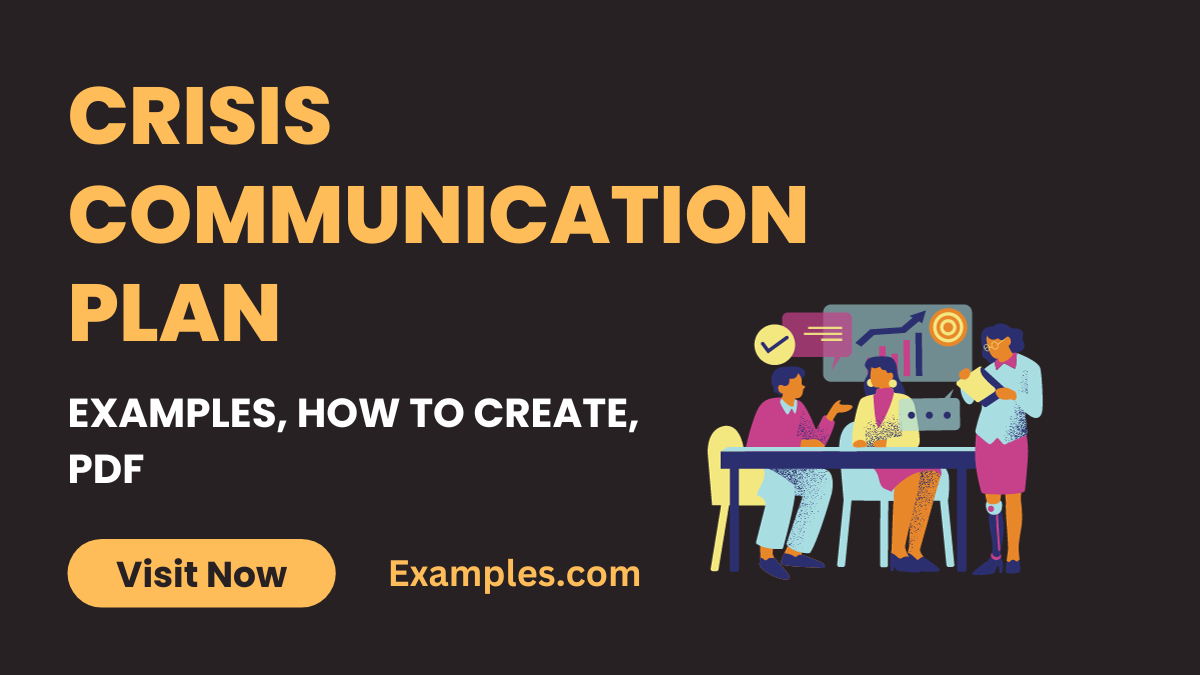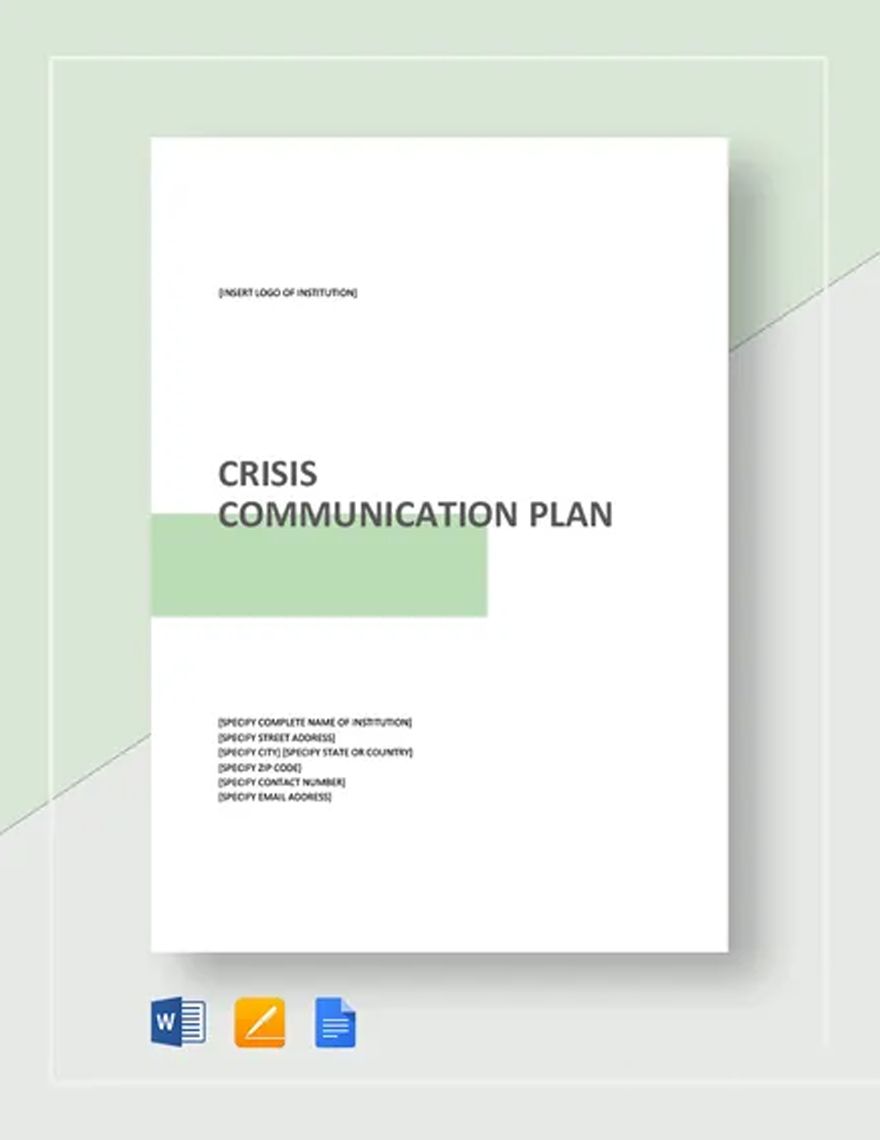6+ Crisis Communication Plan Examples
Embark on a definitive journey through Crisis Communication Plans with our complete guide, brimming with practical Communication Examples. This resource is designed to empower you with strategies to navigate Interpersonal Silence, tackle Emotional Disconnection, and resolve Non-Verbal Misunderstandings. Whether you’re facing Conflict Avoidance in a team or Trust Erosion in a relationship, this guide offers insightful examples and actionable solutions to enhance your communication resilience in times of crisis.
Download Crisis Communication Plan Bundle
Crisis Communication Plan
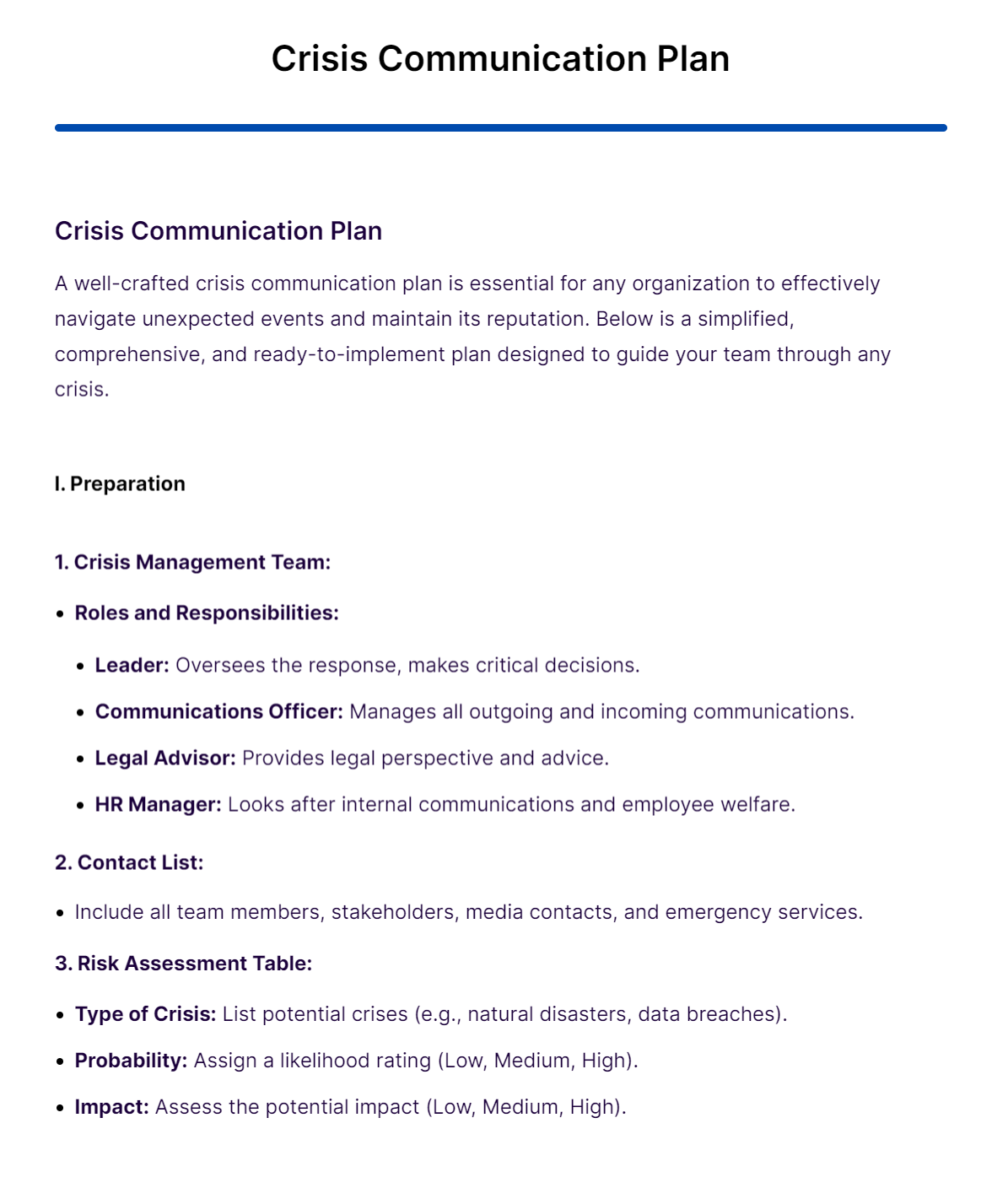
The page provides an in-depth guide on crafting a crisis communication plan. It emphasizes the importance of preparation, response, and recovery, detailing team roles, risk assessments, and communication strategies. This comprehensive plan is designed to help organizations navigate crises effectively and maintain their reputation
Crisis Communication Plan for Schools
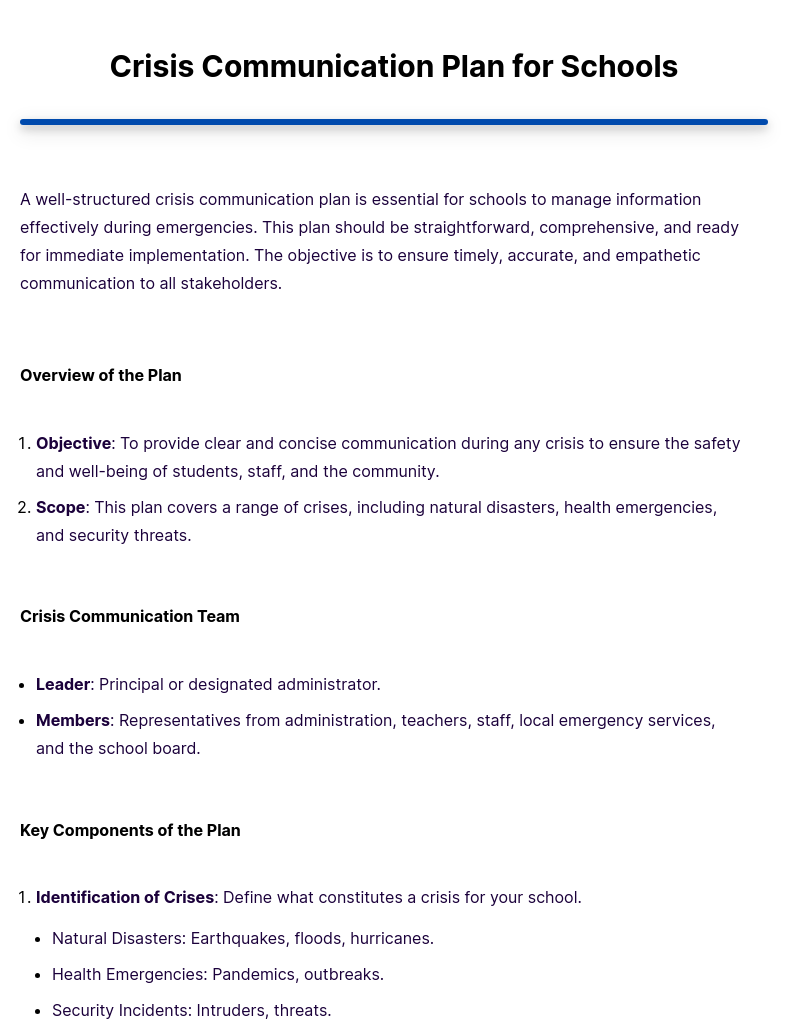
The Crisis Communication Plan for Schools to establish a crisis communication plan. It emphasizes the need for clarity, comprehensiveness, and readiness in managing emergencies, ensuring timely and empathetic information dissemination. Covering various crises, from natural disasters to security threats, it’s an invaluable resource for safeguarding students, staff, and community well-being.
Crisis Communication Plan for Construction

The Crisis Communication Plan for Construction is a comprehensive guide designed for the construction industry. It outlines the structure and responsibilities of a crisis communication team, types of crises, communication channels, and key messages before, during, and after a crisis. This plan is crucial for ensuring safety, minimizing damage, and maintaining stakeholder trust during emergencies
Crisis Communication Plan for Business
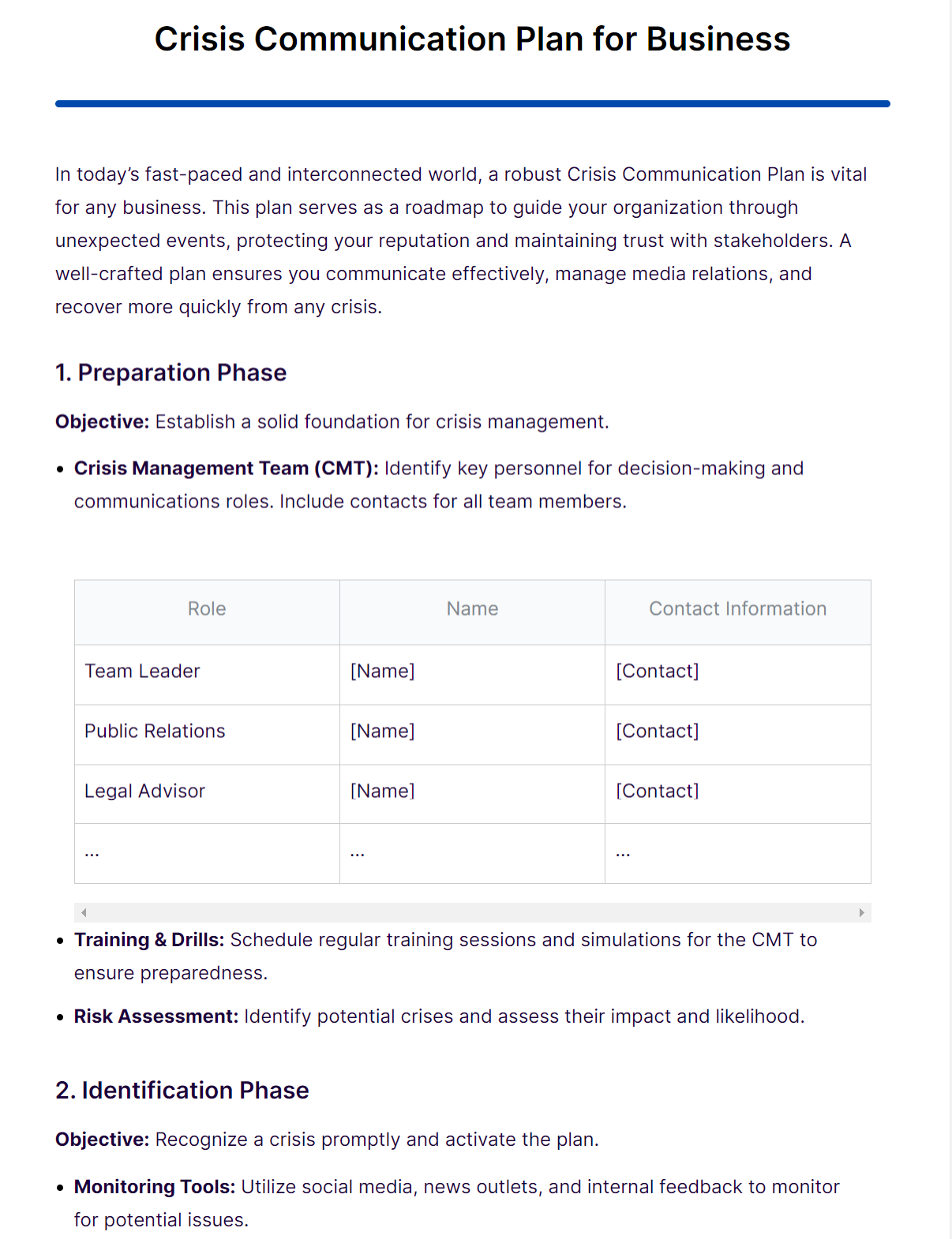
The comprehensive breakdown of crafting a Crisis Communication Plan tailored for businesses. It emphasizes the importance of preparedness, response, and recovery, with detailed steps to ensure a business can navigate through crises while maintaining its reputation and stakeholder trust. A valuable tool for any organization, it guides through effective communication and strategic planning.
Crisis Communication Plan in Company
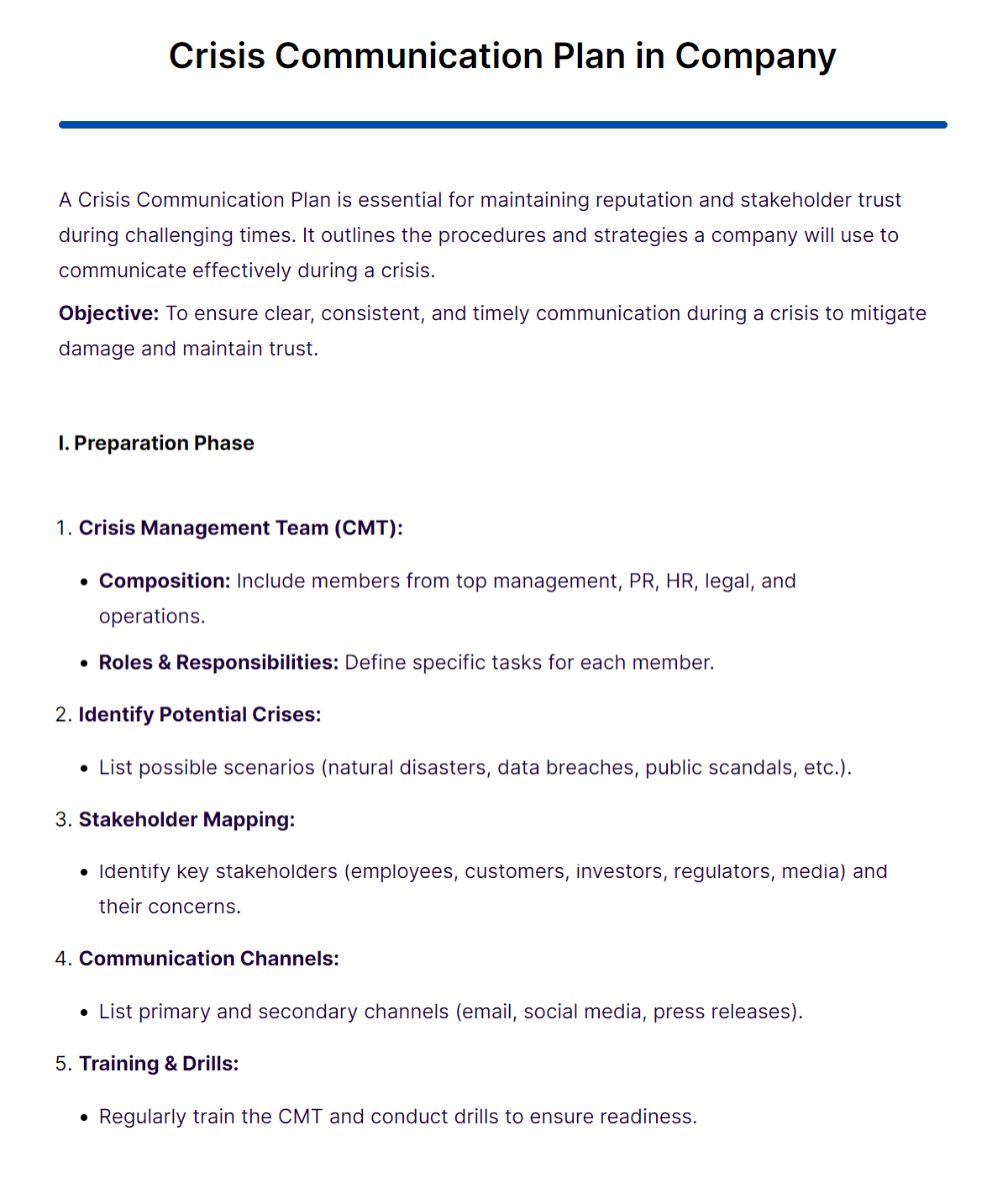
The criticality of a Crisis Communication Plan in companies. It emphasizes the need for clear, consistent, and timely communication during crises to mitigate damage and maintain stakeholder trust. Key sections cover preparation, detection, response, and recovery, with tools and resources to ensure companies are fully prepared to handle any crisis efficiently.
Crisis Communication Plan in Hospital
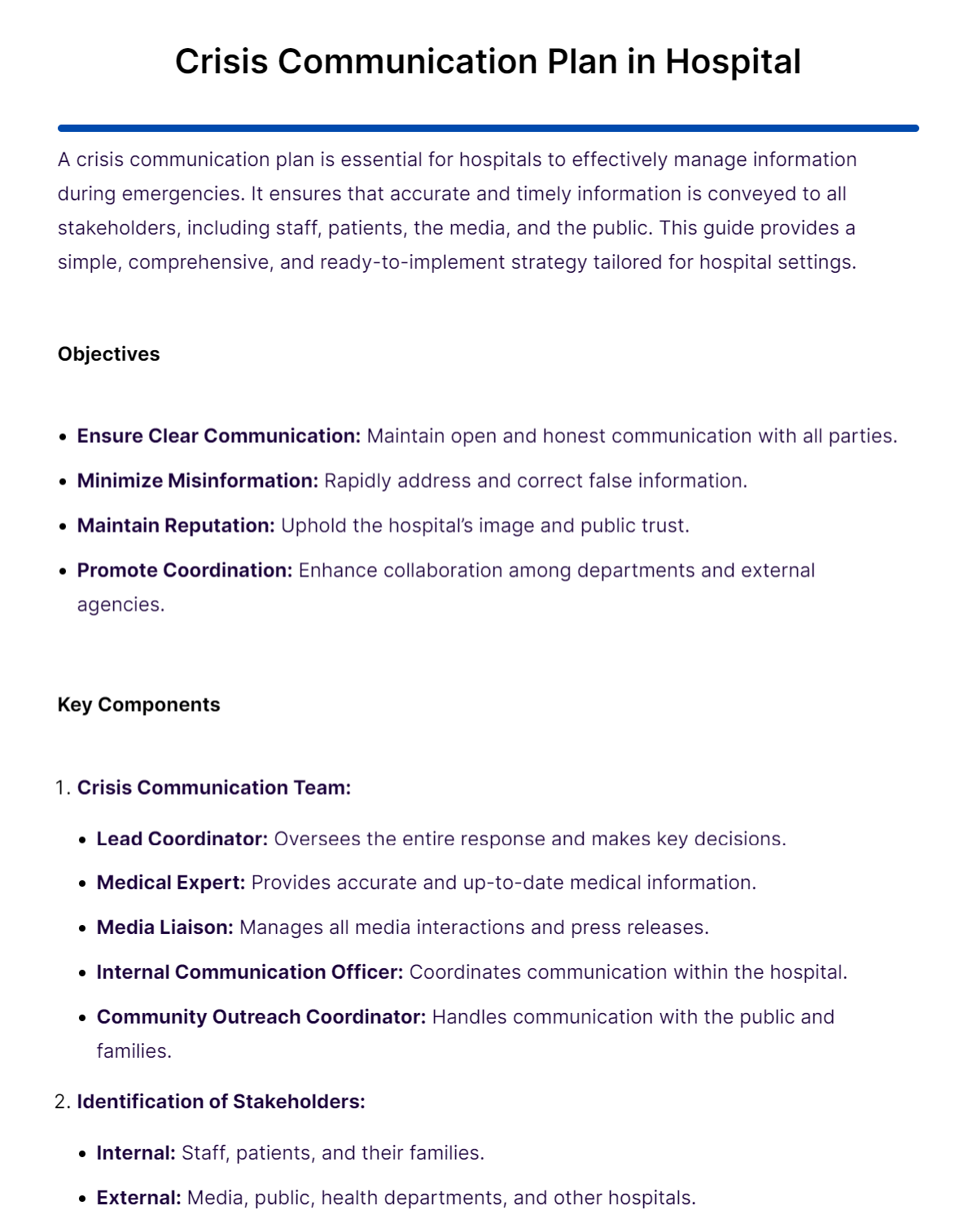
The crisis communication plan specifically for hospitals. It outlines essential elements like team roles, stakeholder identification, and communication channels. Emphasizing preparation, response, and review phases, it’s an invaluable resource for ensuring accurate, timely communication during emergencies in healthcare settings.
Crisis Communication Plan Template
Business Crisis Communication Plan Template
Community Crisis Communication Plan Template
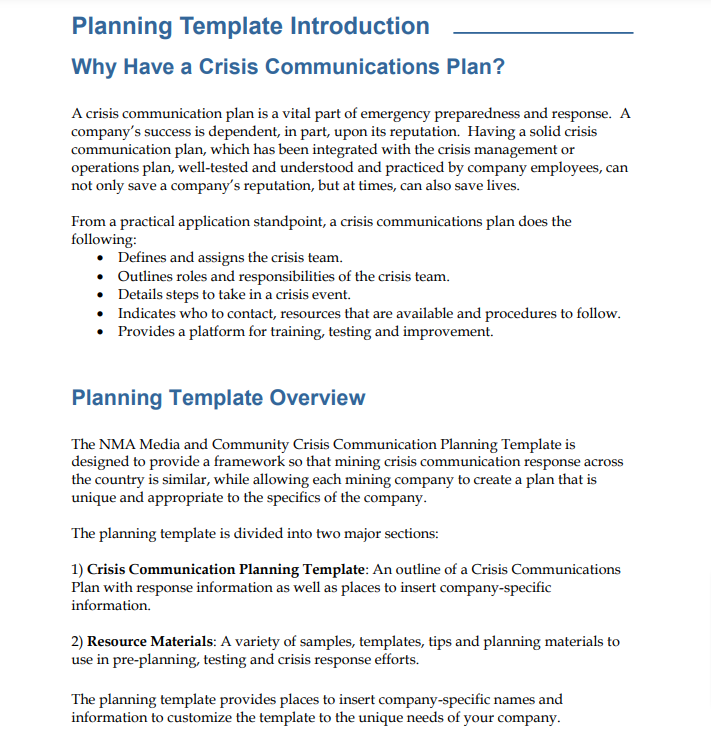
nma.org
DownloadCrisis Communication Strategy Plan Template
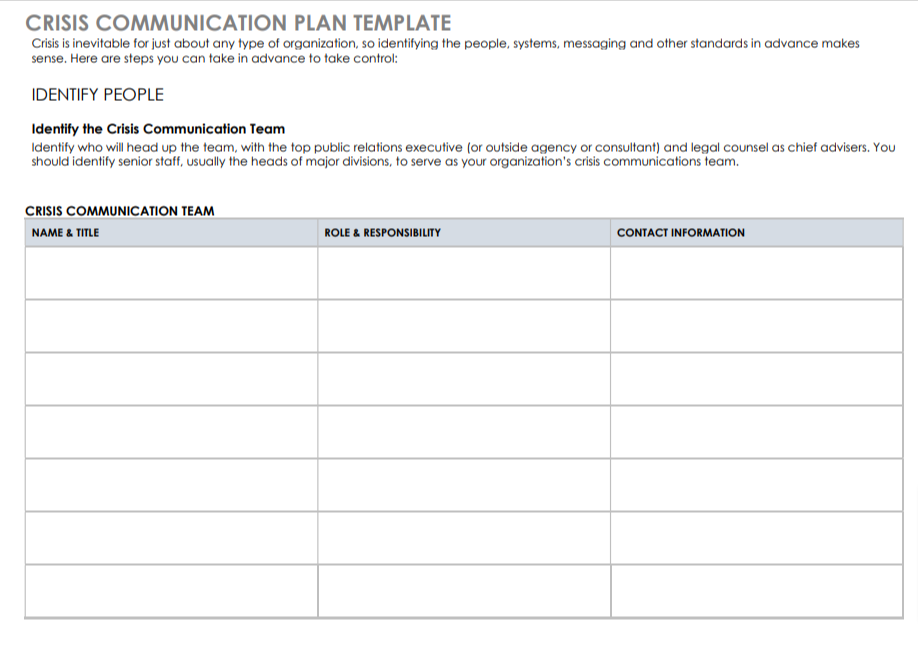
caljac.org
DownloadKey Components of a Crisis Communication Plan
A Crisis Communication Plan is crucial for effective emergency management, ensuring preparedness and coordinated response. It encompasses strategies for risk assessment, communication channels, team roles, community engagement, and media relations. Including training, drills, and evaluation mechanisms, this plan helps organizations maintain trust and control during crises, making it an indispensable tool for proactive crisis management and resilience building.
- Assessment Procedures
- Insight: Evaluates potential risks and prepares for various crisis scenarios.
- Sentence: “Our risk assessment highlights the need for updated crisis response strategies.”
- Designated Communication Channels
- Strategy: Identifies primary and secondary channels for information dissemination during a crisis.
- Sentence: “We will use email and social media to provide timely updates in any emergency situation.”
- Clear Roles and Responsibilities
- Plan: Assigns specific tasks to team members for organized crisis management.
- Sentence: “John, as our spokesperson, will handle all media inquiries during the crisis.”
- Community Engagement Strategy
- Approach: Outlines effective communication and involvement with the community.
- Sentence: “A community meeting is scheduled to discuss preparedness and gather valuable feedback.”
- Media Relations Plan
- Tactic: Details protocols for interacting with the media to ensure accurate information dissemination.
- Sentence: “Our designated media liaison will issue regular press updates to ensure transparency.”
- Training and Drills
- Preparation: Ensures readiness through regular training and practical exercises.
- Sentence: “The upcoming drill will test our response to a simulated power outage scenario.”
- Resource Allocation
- Management: Determines necessary resources for effective crisis communication.
- Sentence: “Additional funding has been directed towards emergency communication tools.”
- Stakeholder Communication Plan
- Framework: Identifies and plans communication with all relevant stakeholders.
- Sentence: “We are revising our stakeholder communication plan to ensure comprehensive coverage.”
- Post-Crisis Review
- Analysis: Evaluates the response to refine future crisis management strategies.
- Sentence: “A thorough review of our crisis response will help us identify areas for improvement.”
- Crisis Message Templates
- Initiative: Prepares pre-written templates for quick and consistent communication during a crisis.
- Sentence: “We’ve developed templates to ensure prompt and accurate information release during emergencies
Implementation Steps for Crisis Communication plan
Implementing steps for a Crisis Communication Plan is about ensuring preparedness and agility in the face of adversity. This guide focuses on actionable strategies to address Interpersonal Silence, navigate through Emotional Disconnection, and tackle Non-Verbal Misunderstandings. It’s tailored to enhance understanding, manage Conflict Avoidance, and rebuild Trust Erosion, ensuring your team or relationship can effectively communicate and respond during critical times.
- Immediate Acknowledgment: As soon as a crisis emerges, promptly acknowledge the situation to prevent panic and speculation.
Quick acknowledgment demonstrates control and commitment to transparency. - Centralize Communication: Designate a single point of communication to ensure consistent and accurate messaging.
This avoids confusion and mixed messages, which can exacerbate the crisis. - Empathetic Tone: Communicate with empathy and understanding, showing stakeholders you’re responsive to their concerns.
An empathetic tone helps maintain trust and calm during tense situations. - Fact Verification: Before releasing any information, verify all facts to avoid spreading misinformation.
Accurate information is crucial to maintain credibility and manage the crisis effectively. - Regular Updates: Provide regular updates to keep stakeholders informed as the situation evolves.
Consistent communication prevents rumors and keeps everyone aligned on the response efforts. - Employee Briefing: Ensure all employees are briefed and understand their roles during the crisis.
Informed employees can better support the response efforts and serve as ambassadors of accurate information. - Stakeholder Prioritization: Identify and prioritize key stakeholders to tailor communication effectively.
Understanding who needs information first helps manage the crisis more efficiently. - Media Handling: Prepare for media inquiries with trained spokespersons who can handle tough questions.
Effective media handling is essential to shape the narrative and control the message. - Feedback Loop: Establish a feedback loop to gauge stakeholder reactions and adapt your strategy accordingly.
Listening to feedback ensures your communication remains relevant and effective. - Post-Crisis Review: After the crisis, conduct a review to identify lessons learned and improve future responses.
Continuous improvement is key to enhancing your crisis communication strategy over time.
What Should be in a Crisis Communications Plan?
A Crisis Communication Plan is an essential framework designed to guide individuals and organizations through the turbulent waters of a crisis. Optimized for understanding and implementing effective communication during challenging times, this plan is a beacon for maintaining order, clarity, and trust when it’s needed most. Here’s what should be meticulously included to ensure your plan is robust, responsive, and reliable.
1. Clear Definition of What Constitutes a Crisis: Begin by outlining what scenarios your organization classifies as a crisis. This could range from Interpersonal Silence and Emotional Disconnection in small teams to major public scandals or financial disasters. Understanding the scope ensures you’re prepared for various situations, including Non-Verbal Misunderstandings and Conflict Avoidance.
2. Crisis Communication Team: Identify a dedicated team responsible for managing communications during a crisis. This team should include members with skills in media relations, stakeholder communication, and strategy planning. They’ll be the front line in preventing Relationship Breakdown and managing Trust Erosion.
3. Stakeholder Mapping: List all potential stakeholders, including employees, customers, partners, and the media. Understanding who needs to be informed helps in addressing Intimacy Challenges and Miscommunication in Couples or teams during high-stress periods.
4. Key Messages: Develop key messages for various crisis scenarios. These should be clear, concise, and tailored to address the concerns and questions of each stakeholder group. Well-crafted messages can prevent Partner Detachment and reduce Expressive Barriers.
5. Communication Channels: Determine which channels you’ll use to communicate during a crisis. This may include press releases, social media, email, or direct meetings. Selecting the right channels is crucial in reaching your audience effectively and avoiding Bad Communication.
6. Monitoring and Updating Procedures: Establish procedures for monitoring public and internal response to the crisis. This includes social media monitoring and feedback collection. Regular updates should be part of the plan to keep all stakeholders informed and reduce Poor Communication Skills.
7. Training and Rehearsal: Conduct regular training for the crisis communication team and rehearse different scenarios. This ensures everyone is prepared and can act swiftly and effectively, reducing the chances of a New Relationship with the public or stakeholders being tainted.
8. Legal Considerations: Consult with legal advisors to understand the implications of the crisis and your communication. This is crucial to ensure that all communications are compliant and do not inadvertently increase liability or Blame.
9. Review and Adaptation Mechanism: Your crisis communication plan should not be static. Include a mechanism for regular review and adaptation based on recent crises, changes in the organization, or shifts in the external environment.
10. Contact Lists: Keep updated lists of contact information for all key team members and stakeholders. In a crisis, reaching the right people quickly is essential.
How to Create a Crisis Communication Plan Strategy?
Creating a Crisis Communication Plan is a proactive step towards ensuring your organization or relationship can effectively navigate and communicate during challenging times. This plan is a strategic asset in managing Emotional Disconnection, Non-Verbal Misunderstandings, and other crises-related issues. Here’s a detailed, step-by-step guide to building a comprehensive plan, optimized for Crisis Communication Plans.
1. Assess Your Risks and Vulnerabilities: Start by conducting a thorough risk assessment. Identify potential crises that could impact your organization or relationship, ranging from natural disasters to Interpersonal Silence or Trust Erosion. Understanding these risks helps tailor your plan to specific scenarios.
2. Define the Crisis Communication Team: Assemble a team of individuals from various departments or aspects of your relationship who will lead the communication efforts during a crisis. This team should include members skilled in communication, decision-making, and strategy, and be trained to handle Conflict Avoidance and Expressive Barriers.
3. Develop Communication Protocols: Outline clear protocols for how information will be communicated during a crisis. This includes identifying who will speak on behalf of the organization or relationship, how updates will be given, and the channels used for communication to avoid Miscommunication in Couples or teams.
4. Identify and Understand Your Stakeholders: Map out all key stakeholders who need to be informed during a crisis. This could include employees, customers, suppliers, and the media. Understanding their needs and concerns is crucial to address potential Relationship Breakdown and maintain Intimacy Challenges.
5. Create Key Messages: Develop key messages for different types of crises. These should be crafted to convey empathy, transparency, and commitment to resolving the issue. Well-prepared messages can mitigate Partner Detachment and reduce Blame.
6. Select Appropriate Communication Channels: Determine the most effective channels to reach your stakeholders. These might include emails, press conferences, social media, or direct meetings. Choosing the right channels ensures your message is received and understood, reducing the chance of Bad Communication.
7. Establish Monitoring and Feedback Systems: Set up systems to monitor how the crisis and your communication are being received. This might include social media monitoring, surveys, or direct feedback. Responsive monitoring helps in adapting your strategy and addressing Poor Communication promptly.
8. Plan for Ongoing Updates and Adaptation: A crisis can evolve rapidly. Plan for regular updates to stakeholders and be prepared to adapt your strategy based on new information and the changing situation. This helps in managing expectations and maintaining trust.
9. Train and Rehearse: Regularly train your crisis communication team and conduct drills to simulate different crisis scenarios. This ensures that when a real crisis hits, your team is prepared and can act quickly and effectively.
10. Review and Revise Regularly: A Crisis Communication Plan should be a living document. Regularly review and update it based on new threats, lessons learned from past crises, or changes in your organization or relationship.
How to Make a Crisis Communication Plan Checklist?
Creating a Crisis Communication Plan Checklist as a table with tick boxes provides a structured and interactive way to ensure all critical elements are considered and addressed.
| No. | Task | Description | Tick Box |
|---|---|---|---|
| 1 | Identify Potential Crises | List and prioritize possible emergency scenarios. | |
| 2 | Assemble Crisis Team | Choose team members and define roles and responsibilities. | |
| 3 | Establish Communication Protocols | Determine primary and secondary communication channels and authorization. | |
| 4 | Develop Key Messages | Prepare adaptable statements for different crisis scenarios. | |
| 5 | Identify and Understand Your Audience | Segment audiences and plan tailored communication strategies. | ? |
| 6 | Train Your Team | Conduct regular drills and training sessions. | ? |
| 7 | Monitor and Update Plan Regularly | Schedule periodic reviews and incorporate feedback. | ? |
| 8 | Legal Considerations | Consult with legal advisors and prepare pre-approved statements. | ? |
| 9 | Resources Allocation | Ensure access to necessary tools and budget for crisis management. | ? |
| 10 | Post-Crisis Analysis | Evaluate the response and gather feedback for improvement. | ? |
Crisis communication plans are crucial for any organization to effectively navigate the unexpected and maintain trust with stakeholders. These plans are comprehensive strategies that enable organizations to communicate effectively during a crisis and mitigate potential damage.
The U.S. government’s Ready.gov provides valuable insights into forming a crisis communication plan. It emphasizes the importance of identifying your audiences, crafting your message, and choosing the right methods and timings to communicate. According to Ready.gov, a well-prepared plan should include a list of potential crises, detailed responses, and designated spokespersons to ensure clarity and consistency in your messages.
Similarly, academic institutions like Youngstown State University (YSU) also recognize the importance of tailored crisis communication strategies. The YSU crisis communication plan offers a framework reflecting the unique environment of an academic campus. It addresses specific scenarios that might affect students, faculty, and staff, ensuring that the plan is comprehensive and addresses the needs of all community members.
Both sources agree on several fundamental steps for effective crisis communication: identifying key stakeholders, training a dedicated response team, regularly updating and testing the plan, and ensuring transparency and accuracy in all communications. Incorporating these principles into your plan will prepare your organization to respond promptly and effectively, preserving your reputation and stakeholders’ trust during critical times.



